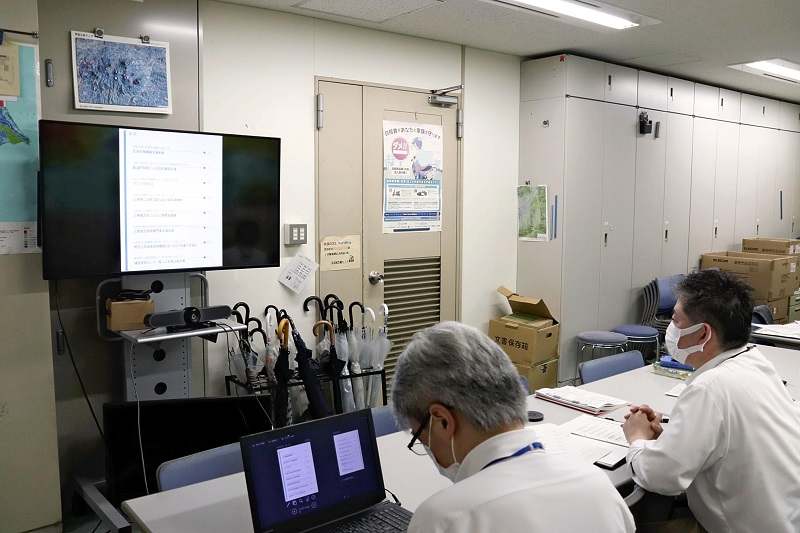
Land, Infrastructure, Transport and Tourism Ministry officials explain new guidelines on support for disaster-hit municipal governments during an online briefing at the ministry in Tokyo on May 26.
10:13 JST, June 15, 2022
The declining number of civil engineers at local governments across Japan is starting to negatively affect authorities’ abilities to respond to natural disasters.
According to the Land, Infrastructure, Transport and Tourism Ministry, the number of such engineers has fallen almost 30% in 20 years due to budget constraints and administrative reforms, forcing local governments to rely on limited personnel to handle disaster reconstruction projects.
Now as the season with a heightened risk of natural disasters striking Japan approaches, the ministry has compiled guidelines for local governments and is providing support that makes it easier for them to work smoothly with the central government and relevant organizations.
Ministry officials were bombarded with questions about the guidelines during an online briefing for municipal governments held May 26 and 27.
“What procedures must be followed to request support following a large-scale disaster?” asked one participant, while another said, “What should we do when reconstruction work costs balloon?”
The guidelines were premised on major disasters that have occurred frequently in recent years, such as Typhoon No. 19 in 2019 and torrential rain that lashed Kyushu in 2020. The government laid out support options for local governments facing a civil engineer shortage, such as dispatching personnel from prefectural governments, having the central or prefectural governments step in to handle reconstruction projects, and using the central government’s equipment and materials. Examples of utilizing such support measures were also introduced.
Representatives from 543 local governments participated in the two-day briefing. However, a ministry official suggested these authorities remain hesitant to seek assistance.
“I got the impression that some local governments are still holding back from asking for help from the state, prefectural governments and relevant organizations such as construction industry associations,” the official said. “Getting acquainted with each other after a disaster occurs is too late. We should hold more events like this briefing so we can build face-to-face relationships with municipal governments.”
According to the ministry, the number of civil engineering-related personnel at local governments across Japan dropped from 184,192 in 2000 to 139,663 in 2020. The shortage is particularly acute among small municipal governments. A survey conducted in 2020 found that 76% of villages across the nation did not have a single civil engineer.
Disasters do not happen in predetermined places. This also can make acquiring experience difficult for civil engineers working for local governments. In the past 10 years, about 40% of local governments have not undertaken even one disaster reconstruction project.
Confusion after disaster
The civil engineer shortage is also affecting disaster reconstruction projects.
Torrential rain that hit Kyushu in July 2020 caused the Kuma River to flood and triggered widespread damage in Kumamoto Prefecture. One building contractor was contacted by multiple officials from the same local government in the prefecture, while another constructor was unable to reach local government officials after signing a contract for reconstruction works.
An official of the Hitoyoshi branch of the prefecture’s construction industry association said, “The local governments were in considerable disarray dealing with a disaster of a scale seen only once in a few decades.”
Representatives from the town of Daigo, Ibaraki Prefecture, participated in the ministry’s briefing.
A tributary of the Kuji River near Daigo flooded during Typhoon No. 19 in October 2019, sending water into the town and causing extensive damage. The town government office was flooded above the floor level. However, Daigo government did not have any civil engineers, so the town asked the central and prefectural governments for personnel to oversee reconstruction work and borrowed garbage trucks and other equipment.
“At first, we didn’t know where to start,” recalled the town’s construction section official. “It’s difficult to newly hire engineering personnel, so we’ll follow the guidelines and work closely with relevant organizations during normal times to help our preparations for the future.”
"Society" POPULAR ARTICLE
-

M4.9 Earthquake Hits Tokyo, Neighboring Prefectures
-

Israeli Tourists Refused Accommodation at Hotel in Japan’s Nagano Pref., Prompting Protest by Israeli Embassy and Probe by Prefecture
-

M7.5 Earthquake Hits Northern Japan; Tsunami Waves Observed in Hokkaido, Aomori and Iwate Prefectures
-

Tsukiji Market Urges Tourists to Avoid Visiting in Year-End
-

High School in Kyoto Says Students Shoplifted during Recent School Trip to Bali, Indonesia
JN ACCESS RANKING
-

Tokyo Economic Security Forum to Hold Inaugural Meeting Amid Tense Global Environment
-

Keidanren Chairman Yoshinobu Tsutsui Visits Kashiwazaki-Kariwa Nuclear Power Plant; Inspects New Emergency Safety System
-

Imports of Rare Earths from China Facing Delays, May Be Caused by Deterioration of Japan-China Relations
-

University of Tokyo Professor Discusses Japanese Economic Security in Interview Ahead of Forum
-

Japan Pulls out of Vietnam Nuclear Project, Complicating Hanoi’s Power Plans























